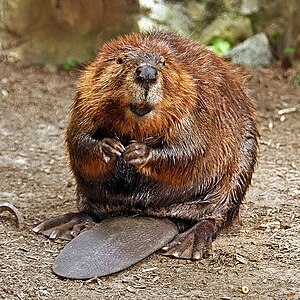Field Guide/Mammals/American Beaver
< Field Guide | Mammals
| Castor canadensis (American Beaver) | |
|---|---|
|
Family: Beaver
Size: The total length of the American Beaver is 3-4 feet (1000-1200mm).
Its average tail length is 10-13 inches (258-325mm).[1] The average weight is 40-50 pounds average (18.1-22.7 Kg); may be up to 90 pounds (40.8 Kg).[2]Description: This species is a large rodent with yellow-brown to black fur. Young beavers have black fur that lightens with age. The under fur is dense while the guard hair is long and coarse. The American Beaver has large teeth and a large, flat, scaled, and hairless tail. The hind feet are webbed for swimming and the front feet are small. All of the feet have claws.[1]
Similar Species: The American Beaver is the largest rodent in North America. Its large teeth and large, flat tail distinguish it from other similar species.
[2]
Range: The American Beaver is generally found throughout North America. The only exceptions are in the peninsula of Florida, the southwest deserts of the United States, and the Arctic Circle.[3]
Habitat: This species lives near lakes, ponds, and streams. They must be near trees for building and a food and water source. American Beavers often reconstruct their habitat to create dams.[3]
Diet: The American beaver is a herbivore. This species will eat most types of plants that surround their habitat including leaves, twigs, bark of trees, and aquatic plants. Their diet varies among seasons. In the summer, American Beavers eat mostly willow leaves and twigs and herbaceous vegetation. In the fall, they store lots of branches and bark to eat in the winter.
[1]
Activity: During the spring, summer, and fall the American Beaver is active about 12 hours a day. They are considered to be nocturnal and diurnal because they are active during parts of the day and night. Beavers activity occurs from early evening until early morning. During the day, they rest in their homes.[1]
Reproduction: American Beavers reproduce only once per year producing a litter of 3-4. They reach sexual maturity around 1 1/2 years old which means they breed during their second winter. Breeding usually occurs from January to February with an average gestation of 107 days. Babies are usually born between May and June although this may vary between February and November.[1]
Lifespan: The average American Beaver lives for twelve years.[2]
Notes: The American Beaver has adapted to have its ears and nose close when going underwater. They may stay under water up to 20 minutes at a time. Babies will swim under water for the first time on the day they are born. Beavers are active woodcutters and dam builders. When they overpopulate an area, they build too many dams which cause floods for the area.
Beavers are listed under least concern on the IUCN Red List.
|
 |
- ↑ a b c d e Jenkins, S; Busher, P (1979), "Castor Canadensis" (PDF), Mammalian Species, vol. 120, pp. 1–8, retrieved October 4, 2012
- ↑ a b c Minnesota Department of Natural Resources (2012), Beaver, retrieved October 4, 2012
- ↑ a b Linzey, A; NatureServe; Hammerson, G; Cannings, S (2011), Castor Canadensis, retrieved October 9, 2012